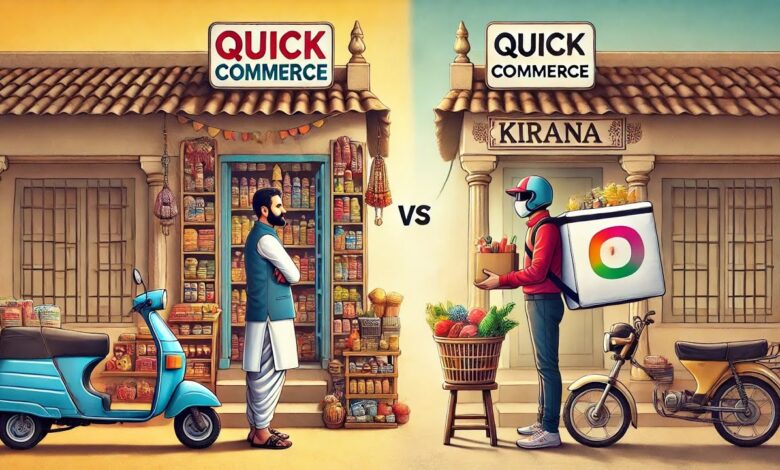
Rinal Rathi : For years, the kirana store was every Indian household’s go-to place for daily needs. From buying groceries on credit to grabbing snacks late at night, the local shopkeeper always had your back.
But things are changing.
Apps like Zepto, Blinkit, and Swiggy Instamart are now promising deliveries in 10 minutes, often with discounts and flashy deals. While customers are loving it, many kirana stores are starting to feel left out.
So, what’s happening? Let’s talk about it in simple words.
What is Quick Commerce?
Quick commerce, or q-commerce, is like online shopping but super fast. Instead of waiting 2–3 days, you get your groceries delivered in 10–20 minutes. All you need is a phone and an app.
These companies have small warehouses in every locality and a bunch of delivery riders always ready. So the moment you order, the item is packed and sent out within minutes.
It sounds great. And honestly, for many people, it is.

Why Are Kirana Stores Losing Customers?
Here’s what’s going against kirana shops right now:
1. Convenience Has Changed
Before, walking to the nearby shop was the easiest option. Now, people prefer tapping on an app and getting everything at their doorstep. Why carry bags when someone else can bring it?
2. No Digital Support
Most kiranas still use notebooks and pens. There’s no app, no online list, no digital payment history. Today’s generation prefers things that are trackable and easy to re-order.
3. No Offers or Cashback
Apps run on investor money and can afford discounts, free items, and cashbacks. Kiranas don’t have those margins. They simply can’t afford to give 20% off on everything.
4. Urban Lifestyle Shift
Young people are used to apps. They don’t want to call and list out items. They want to scroll, tap, and pay. The old way feels slow to them.
5. Perception Matters
Even if the kirana shop sells good products, people assume things coming from apps are better packed, cleaner, and more reliable.

Is This the End for Kiranas?
No, not at all.
Kirana stores still have a big role to play, especially in small towns, villages, and even many parts of cities. But yes, they need to change a bit.
How Can Kiranas Keep Up?
1. Go Digital Even in a Small Way
They don’t need to build an app. Just using WhatsApp to take orders, accepting UPI payments, and keeping digital records can go a long way.
2. Partner with Bigger Platforms
Apps like JioMart, Amazon Easy, and Udaan are helping kiranas become more competitive. These tie-ups give them tech tools, better prices, and delivery support.
3. Use Their Strength: Local Relationships
No app can remember your daughter’s exam date, give you credit when you’re short on cash, or send goods even if you forget to pay. That’s the real power of kirana stores—and they should double down on that.
A Mixed Future Ahead
Quick commerce isn’t going anywhere. But neither are kirana stores.
What will likely happen is a hybrid model: local shops becoming a bit more tech-savvy and platforms using kiranas for last-mile delivery.
And honestly, that sounds like the best of both worlds.
Final Thoughts
Change is tough. And yes, kirana shop owners are facing pressure right now. But with small steps like digital payments, customer service, and smart partnerships, they can adapt.
Because even in a fast world, there’s always room for the familiar, friendly shop around the corner.




